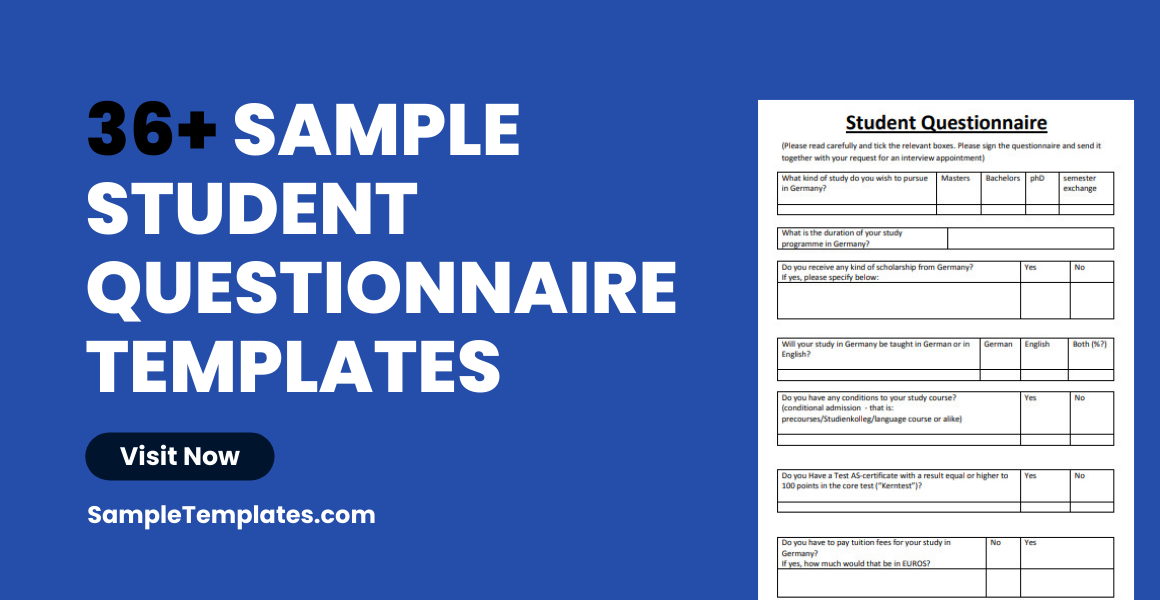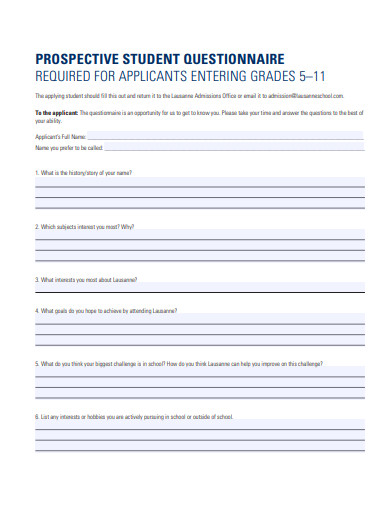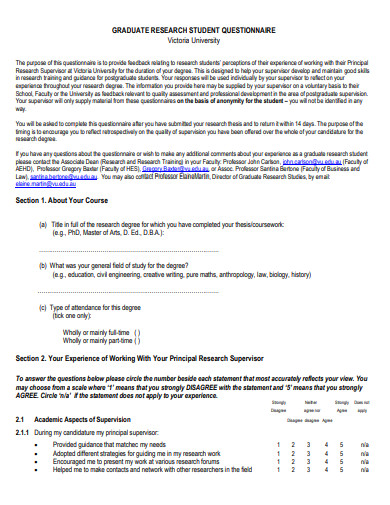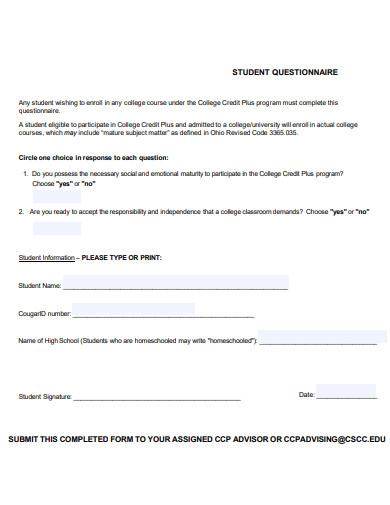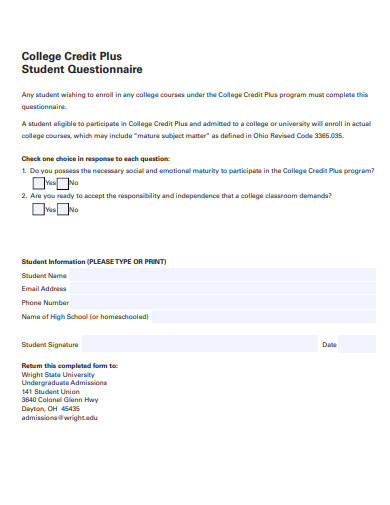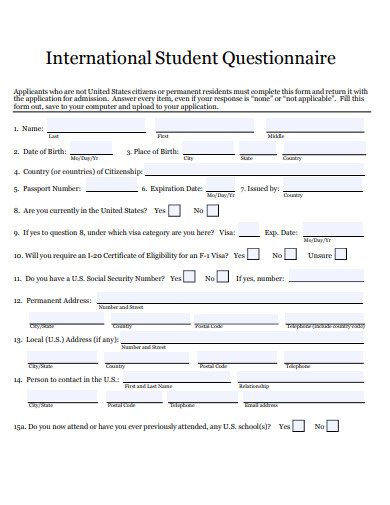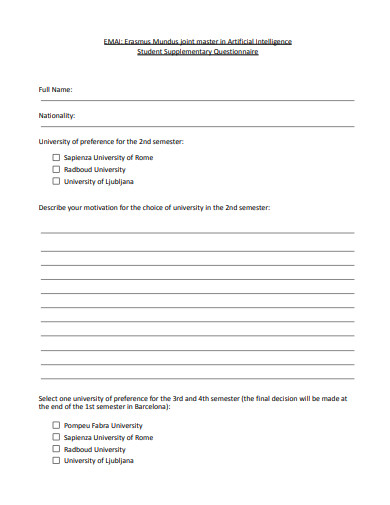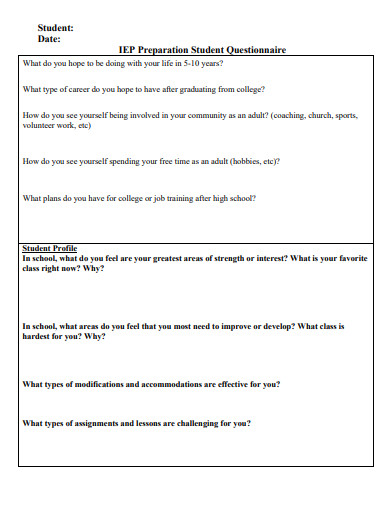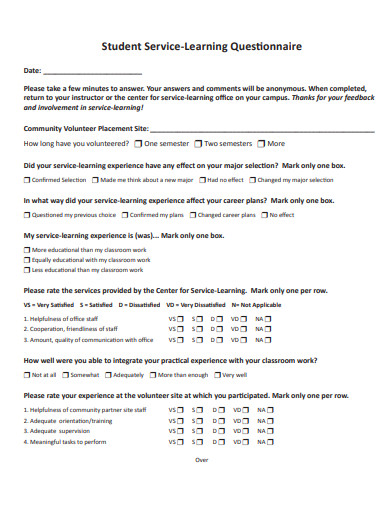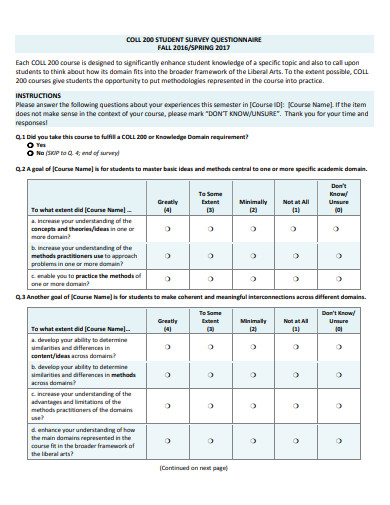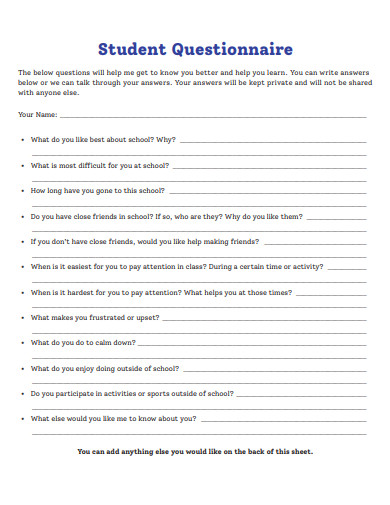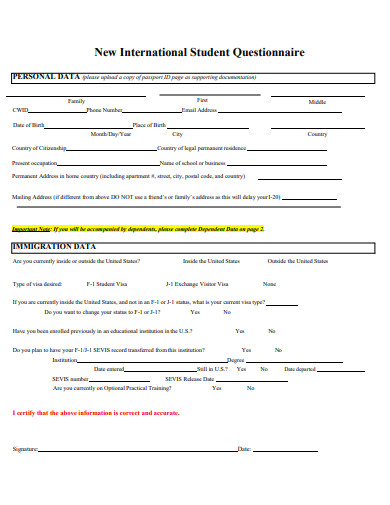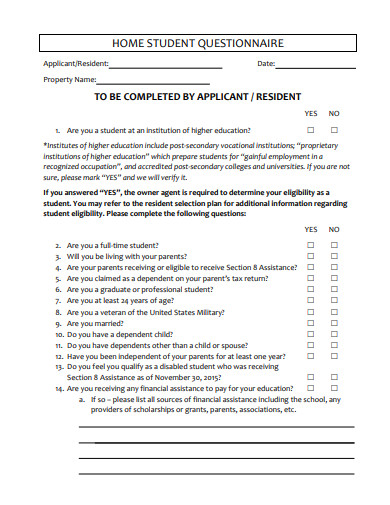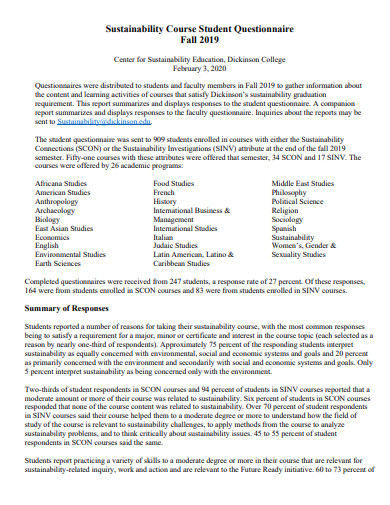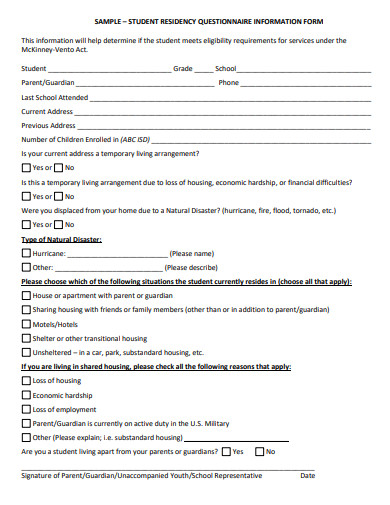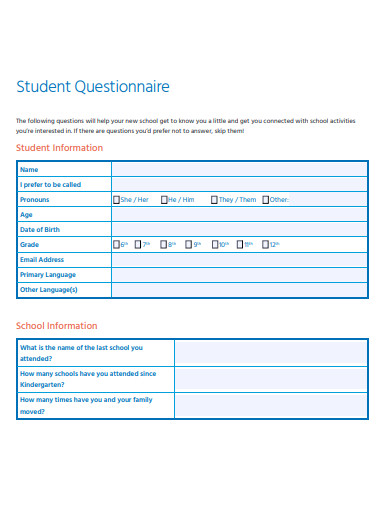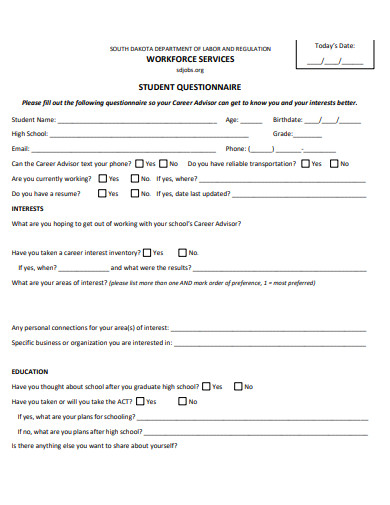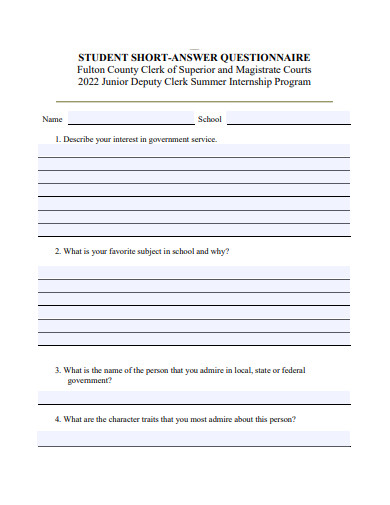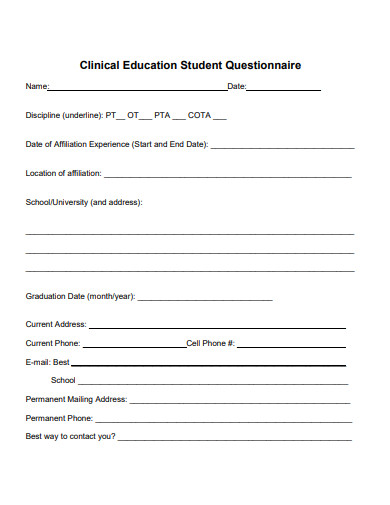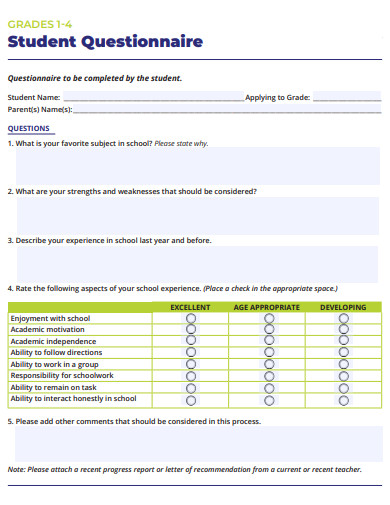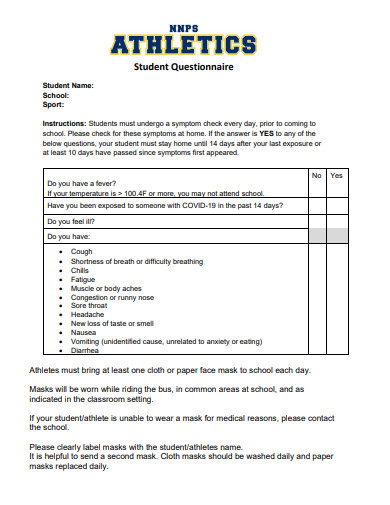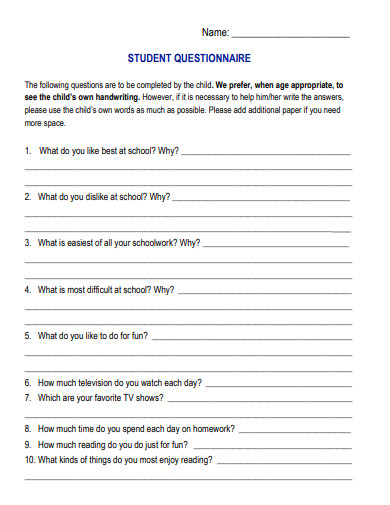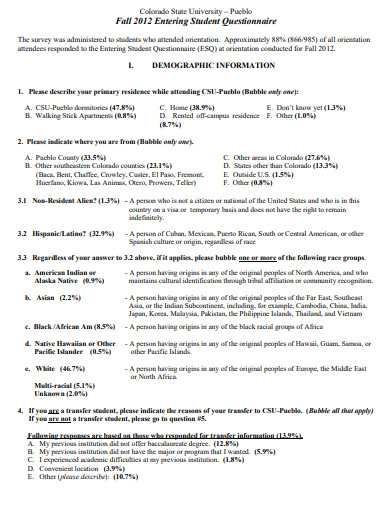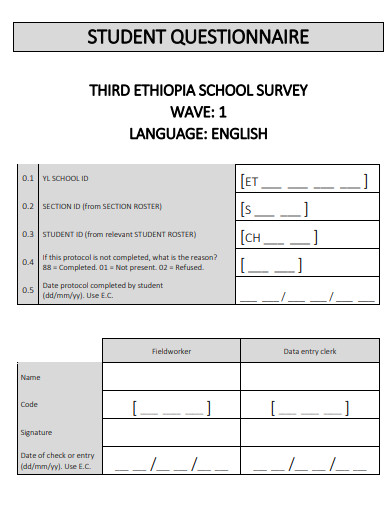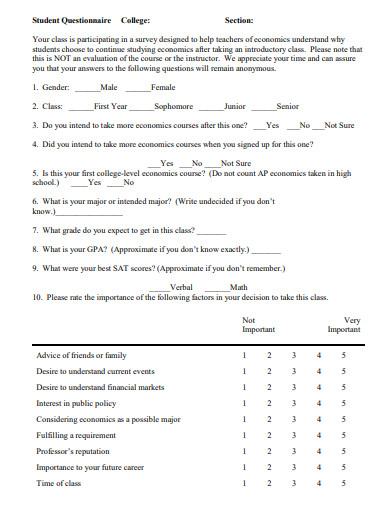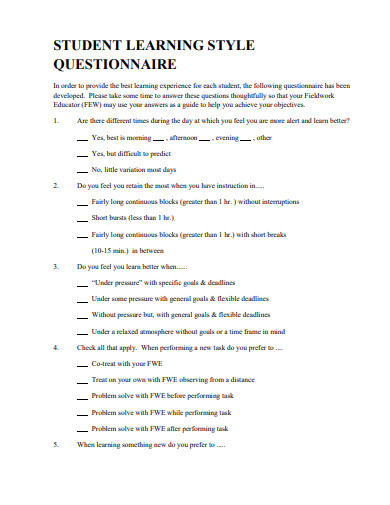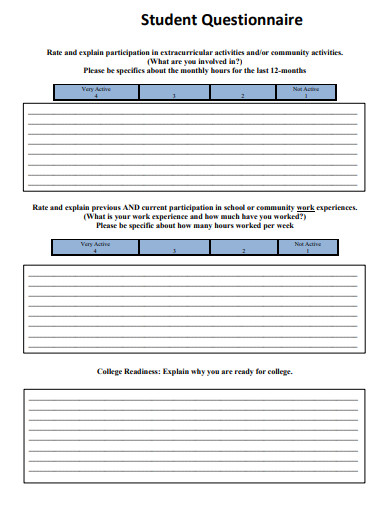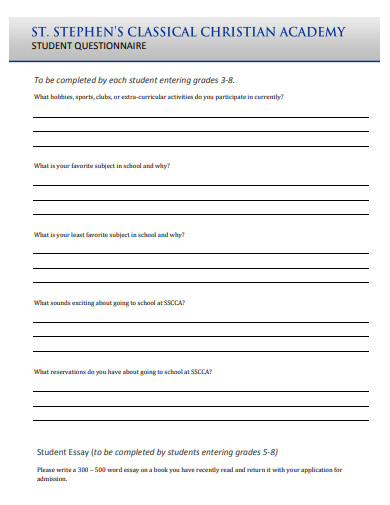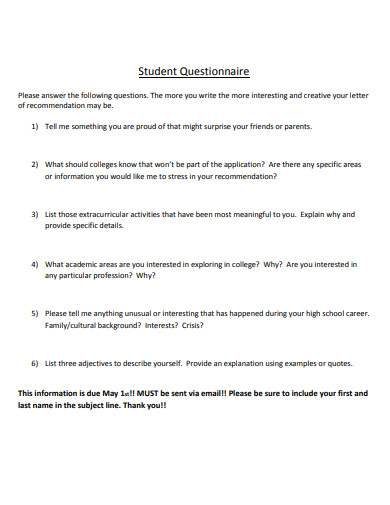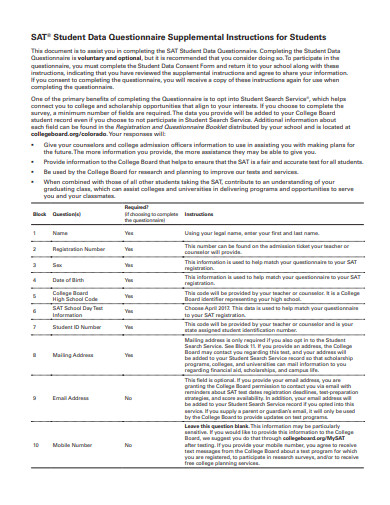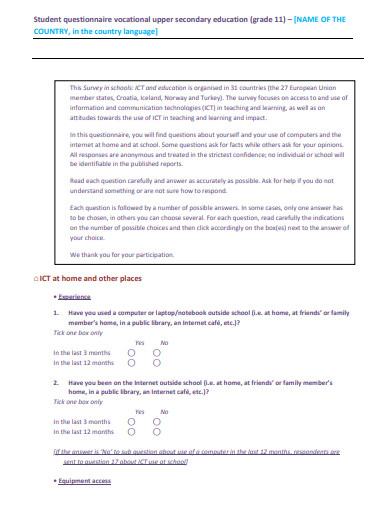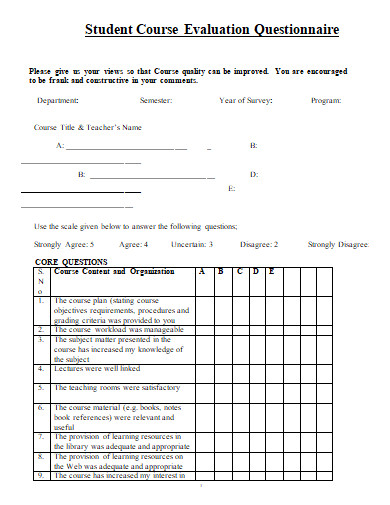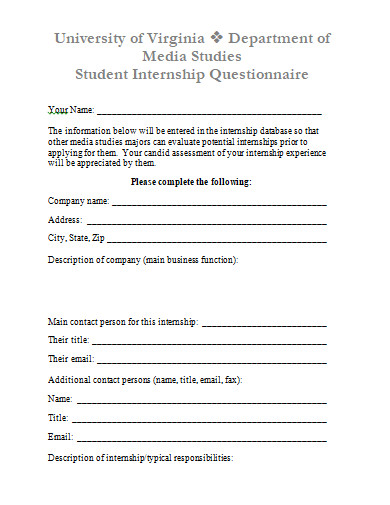Understanding students is the cornerstone of effective education. The Sample Student Questionnaire Template emerges as an essential tool in this quest, meticulously crafted to gauge diverse student experiences and viewpoints. By harnessing the power of targeted questions, educators, and researchers can better align their methods with student needs. Delve into this resourceful Questionnaire template, and uncover valuable insights that will undoubtedly shape and refine the academic landscape. Ideal for those eager to amplify their teaching impact.
36+ Student Questionnaire Samples
1. Student Questionnaire Template
2. Sample Student Questionnaire Template
3. Prospective Student Questionnaire Template
4. Graduate Research Student Questionnaire Template
Understanding the Student Questionnaire
A student questionnaire, at its core, is an invaluable tool for educators and institutions to gather insights directly from the student body. It delves deep, offering a window into a student’s journey, experiences, and perspectives. But what exactly is it, and why is it crucial?
The Essence of a Student Questionnaire
Simply put, a student questionnaire is a structured set of questions designed to collect feedback, opinions, and information from students. The content can vary, ranging from academic experiences to emotional well-being. It is tailored to achieve specific objectives, whether to understand classroom dynamics, evaluate course content, or assess institutional facilities.
Diverse Objectives, One Tool
While the format might differ, the core objectives of a student questionnaire include:
Academic Feedback: These questionnaires can probe into students’ perceptions of course content, teaching methodologies, and academic challenges.
Environment Assessment: How conducive is the classroom atmosphere? Is the institution providing adequate facilities? These questions help educators create better learning environments.
Well-being Checks: In an age where mental and emotional health is paramount, questionnaires can serve as checkpoints to gauge student well-being.
Educator Evaluations: Honest feedback about educators can be collected, helping them improve and adapt their teaching styles.
Types and Formats
Student questionnaires are not monolithic. They vary based on their objectives. Some common types include:
Course-centric Evaluations: Targeted at specific courses or subjects, often used at the end of a term.
Institutional Surveys: A macro view of a student’s experience in the institution, ranging from campus life to administrative efficiency.
Emotional Well-being Surveys: Aimed at understanding the emotional and mental health challenges faced by students.
Self and Peer Reviews: Encouraging introspection and feedback within the student community.
Crafting an Effective Questionnaire
The effectiveness of a questionnaire hinges on its design. Here are some guidelines:
Clarity is Key: Questions should be easily understood, eliminating any potential confusion.
Stay Objective-Oriented: Every question should align with the overarching goal of the survey.
Neutrality Matters: Avoid leading questions that could skew results.
Prioritize Anonymity: This often encourages more genuine responses.
Diverse Question Types: A combination of multiple-choice and open-ended questions can provide a richer data set.
Student questionnaires, when designed and implemented effectively, can be transformative. They not only amplify student voices but also pave the way for meaningful changes in the educational landscape. Through this feedback mechanism, institutions and educators can create an evolving ecosystem that truly resonates with the student community.
5. Basic Student Questionnaire Template
6. College Credit Plus Student Questionnaire Template
7. International Student Questionnaire Template
8. Student Supplementary Questionnaire Template
9. Preparation Student Questionnaire Template
10. High School Student Questionnaire Template
11. Student Service-Learning Questionnaire Template
12. Sub-Internship Medical Student Questionnaire Template
Creating a Robust Student Questionnaire: Step-by-Step Guide
The role of feedback in the educational journey cannot be underestimated. In the realm of academia, one of the most potent tools to gather this feedback is a student questionnaire. But how do you craft one that’s both insightful and effective? Let’s break down the process step by step.
Set Clear Objectives:
Begin with the end in mind. What do you want to find out? Whether it’s gauging student satisfaction, understanding learning challenges, or collecting views on campus facilities, defining your objectives will guide every subsequent step.
Research Existing Templates:
While uniqueness is valuable, there’s no need to start from scratch. Many institutions and researchers have shared questionnaire templates. Reviewing these can offer inspiration and help identify industry standards.
Choose the Right Question Type:
There are various types of questions you can incorporate:
Open-ended: Provides depth and nuance but requires more effort to analyze.
Close-ended: Efficient and easy to analyze; options include multiple-choice, rating scales, and yes/no queries.
Ranking Questions: Ask students to prioritize or rank items in a specific order.
Demographic Questions: Gather background information, but use sparingly and ensure relevance.
Write Clear and Neutral Questions:
Complex vocabulary or leading questions can skew results. Use plain language and ensure each question is unbiased and straightforward.
Keep It Concise:
While it’s tempting to ask about every possible detail, a shorter, focused questionnaire is more likely to be completed. As a rule of thumb, aim for it to be completable in 10-15 minutes.
Design with Logic:
Group similar questions together for a better flow. It’s often effective to start with broader, general questions, gradually moving to more specific ones.
Add a Progress Bar (for Digital Formats):
If your questionnaire is online, a progress bar can be helpful. It provides respondents with a sense of how much they’ve completed and how much remains.
Pilot Test:
Before rolling it out to the entire student body, conduct a pilot test with a smaller group. This trial run can help identify ambiguous questions, areas of confusion, or technical hiccups in digital formats.
Guarantee Anonymity:
Students are more likely to provide honest feedback if they know their responses can’t be traced back to them. Clearly communicate the confidentiality of their answers.
Feedback Collection and Analysis:
Once responses start pouring in, employ statistical tools or qualitative analysis methods, depending on the question types. Look for patterns, outliers, and recurring themes.
Act on the Results:
The essence of gathering feedback is to act upon it. Whether it’s changing pedagogical methods, improving facilities, or addressing student well-being issues, use the insights to inform actionable steps.
In Summary:
Crafting a student questionnaire is an exercise in precision, empathy, and clarity. When done right, it can open doors to invaluable insights that can significantly improve the academic experience. Remember, the key is not just to listen but to act on what you’ve learned.
13. Student Survey Questionnaire Template
14. Formal Student Questionnaire Template
15. New International Student Questionnaire Template
16. Home Student Questionnaire Template
17. Sustainability Course Student Questionnaire Template
18. Student Residency Questionnaire Template
19. Student Questionnaire Example
20. Workforce Services Student Questionnaire Template
21. Student Short Answer Questionnaire Template
22. Clinical Education Student Questionnaire Template
23. Student Questionnaire in PDF
24. Athletics Student Questionnaire Template
25. Standard Student Questionnaire Template
26. Entering Student Questionnaire Template
27. Simple Student Questionnaire Template
28. College Student Questionnaire Template
29. Student Learning Questionnaire Template
30. Student Questionnaire Format
31. Student Job Questionnaire Template
32. Academy Student Questionnaire Template
33. Draft Student Questionnaire Template
34. Student Data Questionnaire Template
35. Upper Secondary Education Student Questionnaire Template
36. Student Course Evaluation Questionnaire Template
37. Student Internship Questionnaire Template
The Art and Science of Creating a Student Questionnaire: A 5-Step Guide
Student feedback is a linchpin for educational growth and improvement. It serves as the bridge between educators’ intentions and students’ perceptions, enabling institutions to refine and optimize the learning experience. Crafting an effective student questionnaire is paramount in this quest, and here’s a succinct 5-step guide to achieving that:
Clarify the Vision:
Why are you seeking feedback? Start by establishing a clear objective for the questionnaire. This could range from evaluating a course’s content to assessing the overall student experience or understanding the challenges faced in a virtual learning environment.
Points to Ponder:
Aim for clarity and precision in your purpose.
Align the objective with broader educational goals or pressing issues.
Design Thoughtful Questions:
The Heart of the Matter: The effectiveness of your questionnaire hinges on the quality of its questions.
Types of Questions:
Open-ended: These provide depth and qualitative insights but can be more demanding in terms of analysis.
Closed-ended: Structured options like multiple-choice or Likert scales offer straightforward, quantitative data.
Demographics: These can provide context but use sparingly and ensure relevance to the objective.
Question Crafting Best Practices:
Keep questions concise and free from jargon.
Avoid leading or biased phrasing to ensure genuine responses.
Structure with Care:
It’s Not Just What You Ask, but How You Ask It: A questionnaire’s flow can influence response quality and completion rates.
Organizational Strategies:
Begin with general or demographic questions, transitioning to specific or personal ones.
Group related questions together for coherence.
Be mindful of length; a focused, concise questionnaire is more likely to be fully completed.
Pilot and Refine:
The Dry Run: Before wide-scale distribution, a pilot phase with a smaller group can offer invaluable insights.
Refinement Insights:
Gauge the time taken to complete the questionnaire.
Identify potentially confusing or ambiguous questions.
Ensure the technology or platform used (especially for digital questionnaires) is user-friendly.
Administer with Assurance and Analyze:
Rollout and Feedback Collection:
Choose an appropriate distribution method: physical handouts, email, learning management systems, etc.
Stress the importance of honesty and ensure participants of their responses’ confidentiality.
Post-Collection Steps:
Analyze results systematically, looking for patterns, anomalies, and areas of concern or excellence.
Communicate findings and intended actions to stakeholders, including students, to close the feedback loop.
A student questionnaire, when designed and executed well, becomes more than just a feedback tool. It becomes a conversation starter, a bridge to understanding, and a catalyst for positive change. By adhering to these five steps, educators and institutions can tap into the wealth of insights that students, as primary stakeholders, can offer, thereby enhancing the educational landscape for everyone involved.
Related Posts
Retirement Speech Samples & Templates
Weekly Schedule Samples & Templates
Contractual Agreement Samples & Templates
FREE 9+ Amazing Sample Church Bulletin Templates in PSD | PDF
Sample Business Card Templates
Sample Cashier Job Descriptions
Questionnaire Samples
FREE 10+ Sample HR Resource Templates in PDF
FREE 49+ Sample Job Descriptions in PDF | MS Word
FREE 23+ Sample Event Calendar Templates in PDF | MS Word | Google Docs | Apple Pages
Company Profile Samples
FREE 10+ Leadership Report Samples [ Development, Training, Camp ]
FREE 24+ Sample Payment Schedules in PDF | MS Word
FREE 10+ Return to Work Action Plan Samples in PDF | DOC
Autobiography Samples & Templates
